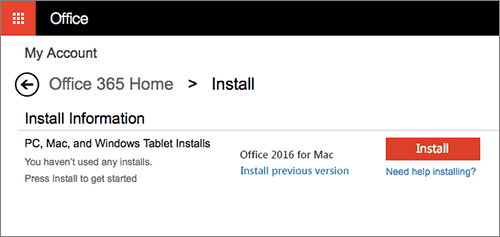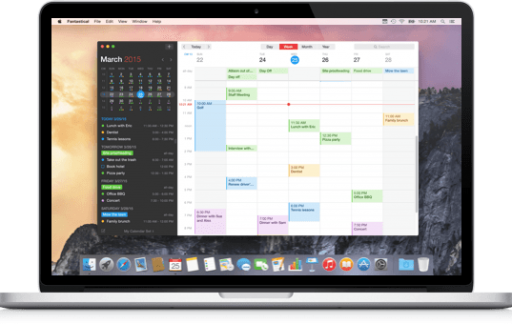Mac Mail High Sierra Microsoft Exchange

- Office 365 Exchange Online
- Exchange Mail Server
- Mac Mail High Sierra Microsoft Exchange 2017
- Mac Mail High Sierra Microsoft Exchange Account
This article describes how to set up your Microsoft Exchange 2010 email account with Mac Mail. Note: Exchange 2010 runs only on Mac OS X version 10.6 or later. If you’re unsure about which OS X version you’re running, click the Apple icon located in the top-left corner and select About This Mac. Open Mac Mail and select Mail Preferences. Exchange ActiveSync will only work on mobile devices, tablets and Outlook 2013. To use an Exchange account with Mac Mail, you'll actually need Exchange Web Services. When you have EWS enabled, you can follow these steps to configure it with Mac Mail: Configure Apple Mail for Exchange Web Services. In the E-mail section click the link Configure Email. If all settings were entered correctly you will see the following page with prompt to select applications you want to use with your Exchange account. Once you have selected applications, click Done. You will see your Exchange account in the Mac Mail Accounts list. Exchange ActiveSync will only work on mobile devices, tablets and Outlook 2013. To use an Exchange account with Mac Mail, you'll actually need Exchange Web Services. When you have EWS enabled, you can follow these steps to configure it with Mac Mail: Configure Apple Mail for Exchange Web Services.
Click Download, or click the link for the language version that you want. Print this page if you want to use it as a reference when you are offline. Make sure that your computer meets the minimum system requirements. Quit any applications that are running, including all Office applications, Microsoft Messenger, and Office Notifications, because they might interfere with the installation. Follow the instructions on the screen to save the file to your hard disk. 
Mail User Guide
Use the Mail app to send, receive, and manage email for all of your email accounts in one location. Simply add the accounts—such as iCloud, Exchange, Google, school, work, or other—you want to use in Mail.
Add an email account
Office 365 Exchange Online
The first time you open the Mail app on your Mac, it may prompt you to add an account. Select an account type—if you don’t see your type, select Other Mail Account—then enter your account information.
If you already added an email account, you can still add more. In Mail, choose Mail > Add Account, select an account type, then enter your account information. Make sure the Mail checkbox is selected for the account.
If you’re using an account on your Mac with other apps, such as Contacts or Messages, you can also use that account with Mail. In Mail, choose Mail > Accounts to open Internet Accounts preferences, select the account on the left, then select the Mail checkbox on the right.
Temporarily stop using an email account
In the Mail app on your Mac, choose Mail > Accounts.
Select the account, then deselect the Mail checkbox.
Now the account’s messages are not shown in Mail.
To use the account again with Mail, select the Mail checkbox; the account’s messages are shown again (they don’t need to be downloaded from the server again).
Remove an email account
When you remove an email account from Mail, the account’s messages are deleted and no longer available on your Mac. Copies of messages remain on the account’s mail server and are still available (from webmail, for example).
Important: If you’re unsure whether messages you want to keep are still on the mail server, move or copy them to a mailbox stored on your Mac (the mailbox appears in the On My Mac section in the Mail sidebar) before you delete the account in Mail.
In the Mail app on your Mac, choose Mail > Preferences, then click Accounts.
Select an account, then click the Remove button .
Note: If the account is used by other apps on your Mac, you’re asked to remove the account in Internet Accounts System Preferences. Click the button to open Internet Accounts, then deselect the Mail checkbox for the account. To stop using the account in all apps, make sure the account is selected, then click the Remove button .

As of September 25, 2017, macOS 10.13 High Sierra is publicly available for all Mac users to install. Office 2016 for Mac is fully supported on High Sierra. For the best experience, we recommend you update Office to version 15.38 or later.
Exchange Mail Server
For updates regarding macOS 10.14 Mojave, see Microsoft Office support for macOS 10.14 Mojave.
Office 2016 for Mac
See 'What version of Office am I using?' if you don't know what version you're on.
Version of Office | Supportability |
|---|---|
15.35 and later | Office 2016 for Mac is fully supported on macOS 10.13 High Sierra. If you encounter issues using Office 2016 for Mac, please send us feedback so we can address them. In Word, Excel, PowerPoint and OneNote, you can click on the Send a Smile icon in the top-right of the app. For Outlook, choose Contact Support from the Help menu. |
15.34 and earlier | These versions are not supported on 10.13. In some cases, you may not be able to launch the Office apps. For example, users will see the following error message when attempting to launch Outlook 2016 ver. 15.34: If you installed Outlook 2016 ver. 15.34 or earlier, and are not being offered an update to 15.35 or later, download the latest Office 2016 for Mac Suite Installer here. |
Office for Mac 2011
Word, Excel, PowerPoint, Outlook and Lync have not been tested on macOS 10.13 High Sierra, and no formal support for this configuration will be provided.
Mac Mail High Sierra Microsoft Exchange 2017
Since October 10, 2017, Office for Mac 2011* is no longer supported. This means there will be no new security updates, non-security updates, free or paid assisted support options, or technical content updates. Refer to the Microsoft Support Lifecycle for more information.
Mac Mail High Sierra Microsoft Exchange Account
* Lync for Mac 2011 has a limited time of Extended Support for security fixes.